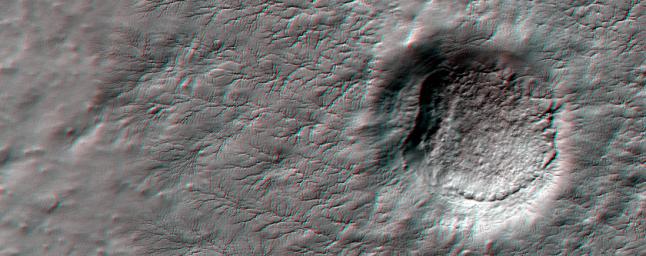
|
Erosion Features near the South Pole of Mars (Anaglyph)
- Click the image above for a larger view
- Full-Res JPEG (840 x 333) (78.2 kB)
- Full-Res TIFF (840 x 333) (840.3 kB)
Caption:
This anaglyph from HiRISE shows erosional features formed by seasonal frost near the south pole of Mars.
During the winter, high latitudes (near the pole) on Mars build up deposits of carbon dioxide frost that can be several feet thick. In the spring these sublimate and turn back into gas. The gas sublimating at the bottom of the frost can move the underlying dust and even erode channels in it.
These channels form a variety of structures; examples like those at this site have been nicknamed "spiders" because many channels converge, giving a many-armed, spidery appearance.
Originally released July 13, 2011
Background Info:
NASA's Jet Propulsion Laboratory, a division of the California Institute of Technology in Pasadena, manages the Mars Reconnaissance Orbiter for NASA's Science Mission Directorate, Washington. Lockheed Martin Space Systems, Denver, built the spacecraft. The High Resolution Imaging Science Experiment is operated by the University of Arizona, Tucson, and the instrument was built by Ball Aerospace & Technologies Corp., Boulder, Colo.
Cataloging Keywords:
| Name | Value | Additional Values |
|---|---|---|
| Target | Mars | |
| System | ||
| Target Type | Planet | |
| Mission | Mars Reconnaissance Orbiter (MRO) | |
| Instrument Host | Mars Reconnaissance Orbiter | |
| Host Type | Orbiter | |
| Instrument | High Resolution Imaging Science Experiment (HiRISE) | |
| Detector | ||
| Extra Keywords | Color, Dust | |
| Acquisition Date | ||
| Release Date | 2011-07-15 | |
| Date in Caption | 2011-07-13 | |
| Image Credit | NASA/JPL-Caltech/University of Arizona | |
| Source | photojournal.jpl.nasa.gov/catalog/PIA14460 | |
| Identifier | PIA14460 | |
